Hickory trees, known for their strength and resilience, belong to the genus Carya and are native to North America and parts of Asia. These remarkable trees are celebrated not only for their durable wood, which is often used for furniture and tool handles, but also for their distinctive nuts, which are a favorite among wildlife and humans alike. With a variety of species exhibiting unique characteristics in terms of bark texture, leaf shape, and nut appearance, hickory trees contribute to diverse ecosystems and offer aesthetic appeal in landscapes.
In this article, we will explore 18 different types of hickory trees, providing pictures and identification tips to help you recognize these magnificent specimens in the wild or your backyard. Whether you are a nature enthusiast, gardener, or simply curious about these trees, this guide will enhance your understanding of hickories and their importance in our environment.
Different Types of Hickory Trees
Black Hickory
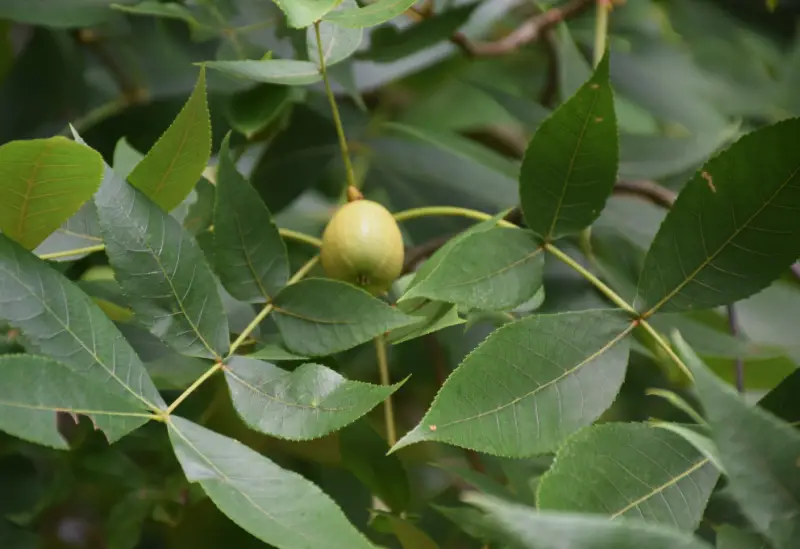
Black Hickory (Carya texana) is a small to medium-sized tree distinguished by its short, crooked branches and narrow crown. Typically, it reaches heights of 30 to 60 feet, rarely exceeding that range, and can form a trunk up to 2 feet in diameter, resulting in a variably shaped crown.
The bark of mature Black Hickory trees is dark gray or brownish gray, featuring a coarse, rough texture that is irregularly furrowed with interrupted ridges. In some cases, the bark may divide into plates, giving it a blocky appearance. The bark on the branches is gray or brownish gray and is less coarse than that of the trunk, providing a contrasting texture.
The twigs are primarily brown and adorned with white lenticels. Young twigs earlier in the growing season are often sparsely covered with powdery yellow or rust-colored scales, though they become glabrous as the season progresses. This combination of features makes Black Hickory a unique and identifiable tree in its native habitat.
The Pecan Tree
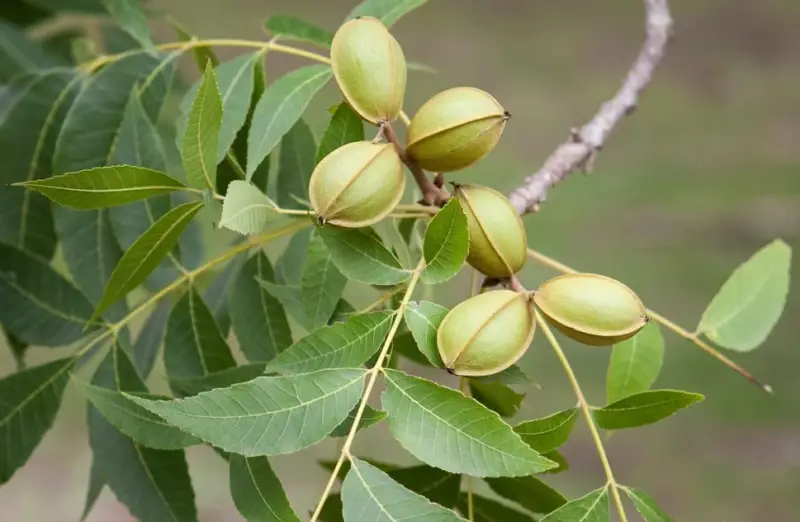
The Pecan Tree (Carya illinoinensis) is known for its impressive size and distinctive form. Open-grown pecan trees feature massive trunks and wide, spreading crowns that extend far down the trunk, creating an oval or rounded shape. In contrast, trees that grow in forested areas typically exhibit a straight trunk and compact, pyramidal crowns.
While pecan trees are beautiful and stately, they are known to shed flowers, leaves, and branches, which some people may find too messy. These large trees can have a spread of up to 75 feet and can grow as tall as 130 feet, with trunk diameters reaching up to 7 feet.
The leaves of the pecan tree are pinnate and grow alternately along the branches. Each leaf measures between 2 to 4 inches long and about an inch wide. Additionally, pecan trees develop a long taproot, with feeder roots that can extend more than 10 feet below the ground, allowing them to access water and nutrients deep in the soil.
Southern Shagbark Hickory
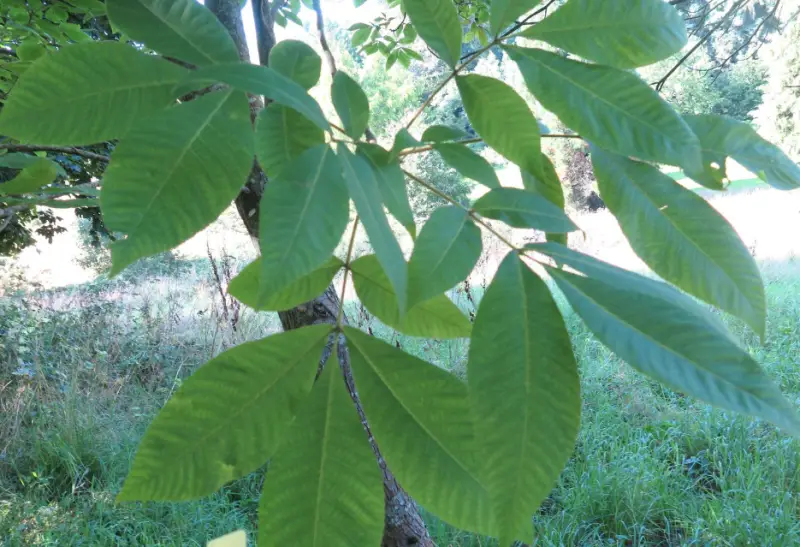
Southern Shagbark Hickory (Carya carolinae-septentrionalis) is often regarded by some botanists as a variety of C. ovata, rather than a distinct species. This small to medium-sized tree features short, crooked branches and a narrow crown, giving it a unique appearance.
The name “Southern Shagbark Hickory” comes from its striking peeling bark. Strips of the tree’s exterior curl outward from one or both ends, creating a textured trunk that is visually appealing. This characteristic adds a rugged charm to the tree, making it stand out in its natural habitat.
Southern Shagbark Hickory primarily thrives in the southeastern United States, particularly in regions with substantial limestone deposits. Its adaptation to these specific soil conditions allows it to flourish, contributing to the biodiversity of the areas where it is found.
Mexican Hickory
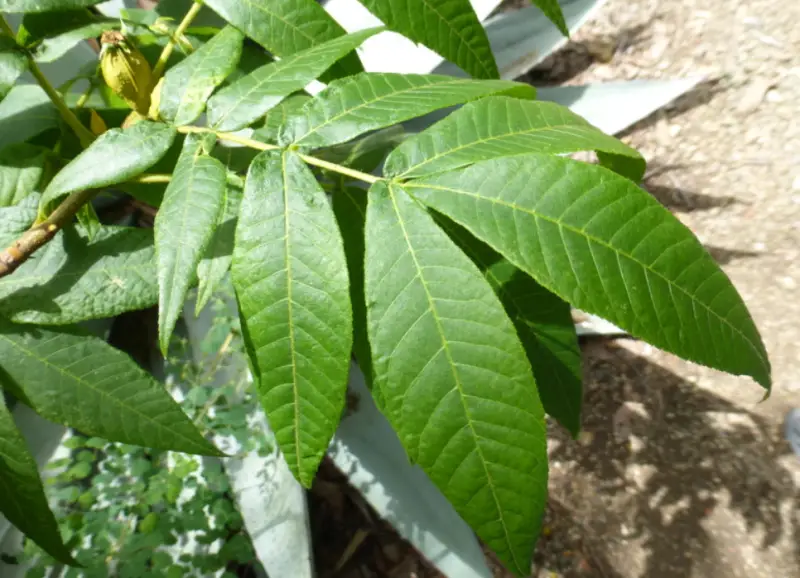
Carya palmeri, commonly known as Mexican Hickory, is a tree species native to Mexico. It was first described by Jacob Warren Manning, who identified it as a member of the Genus Carya based on the characteristics of its leaves, flowers, fruits, and wood.
The Mexican Hickory features brownish-gray bark that tends to peel away in plates, giving the tree a distinctive appearance. Its leaves are shiny green with a silvery underside, contributing to its aesthetic appeal. The round nutshells are reddish-brown and exhibit patterns that resemble nutmegs, while the kernels inside are known for their mild sweetness.
Mexican Hickories can grow up to 100 feet (30 meters) tall, but they are found in scattered populations across some of the southern states, making them a rare sight in their range. This unique tree adds to the diversity of the ecosystems it inhabits, showcasing both beauty and ecological value.
Shagbark Hickory
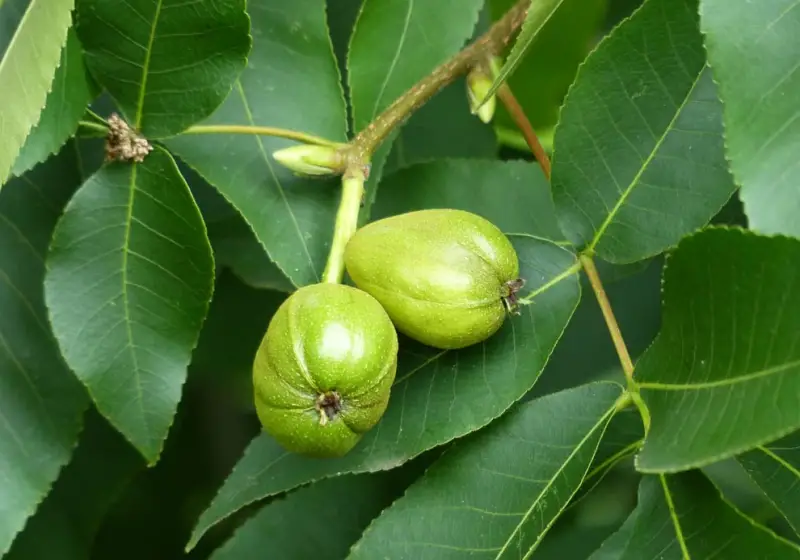
Shagbark Hickory (Carya ovata) is renowned for its distinctive ornamental quality—its smoke-gray bark, which peels away from the trunk in long, foot-length plates. The edges of these bark plates curl outward, giving the tree a rugged.
In late spring, the tree becomes particularly striking when its winter buds open. The scales of these buds unfold like petals, allowing new foliage to emerge gracefully. During the summer, the tree’s delicate, downy leaves provide a medium level of shade, offering a soft, dappled light beneath its canopy.
In addition to its beauty, Shagbark Hickory produces tasty, edible nuts, making it a tree that is both visually appealing and practical.
Shellbark Hickory
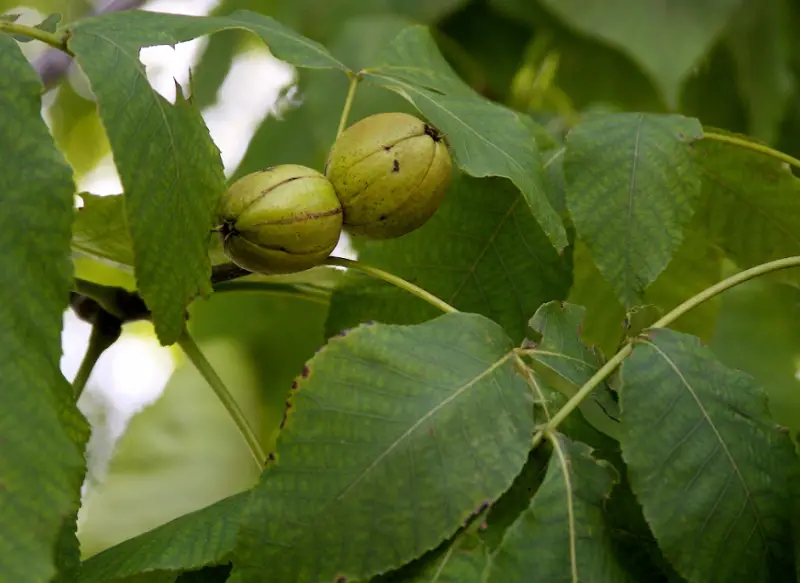
Shellbark Hickory (Carya laciniosa) is similar to both pignut and shagbark hickories, sharing many of their traits. It is known for its high-branching structure, featuring a straight, slender trunk and a narrow, oblong crown.
The tree typically has 7 to 9 leaflets, with the terminal leaflet being noticeably larger than the lateral ones. Shellbark Hickory grows slowly and is often found in deep bottomland soils, particularly near rivers and creeks.
One of its advantages is its resistance to forest pests and pathogens, making it hardier than other hickory species. Additionally, it is sometimes referred to as “king nut hickory” due to its large nuts, the biggest among all hickories.
Pignut Hickory
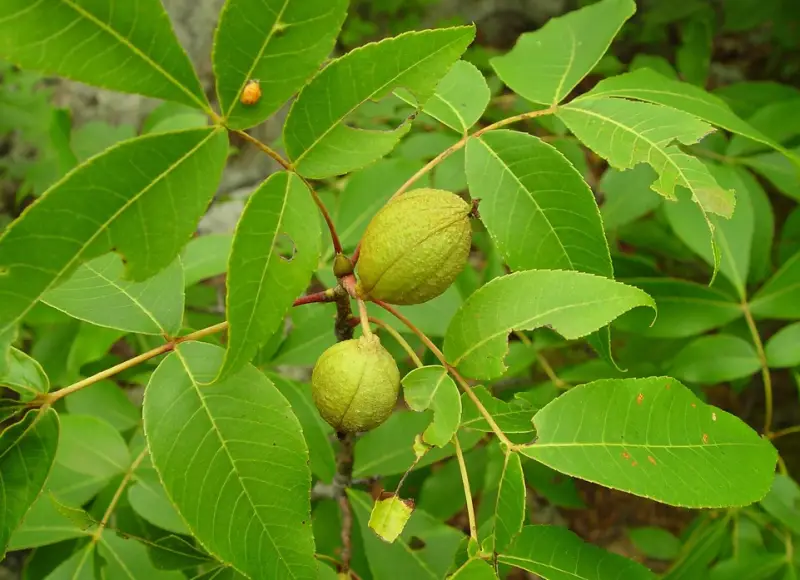
Pignut Hickory (Carya glabra) provides light, airy foliage in the summer, casting a medium shade beneath its canopy. During the winter months, the tree’s open structure and interesting bark make it a point of visual interest.
The tree is particularly striking in late spring when its winter buds open. The scales of the buds peel back like petals, allowing the new foliage to unfurl gracefully. Pignut Hickory is best suited for large, park-like settings where its considerable size, along with its leaf litter, fruit, and fallen twigs, won’t pose a problem.
Its flavorful nuts are highly attractive to squirrels and other animals, which can be unwelcome in residential areas.
Mockernut Hickory
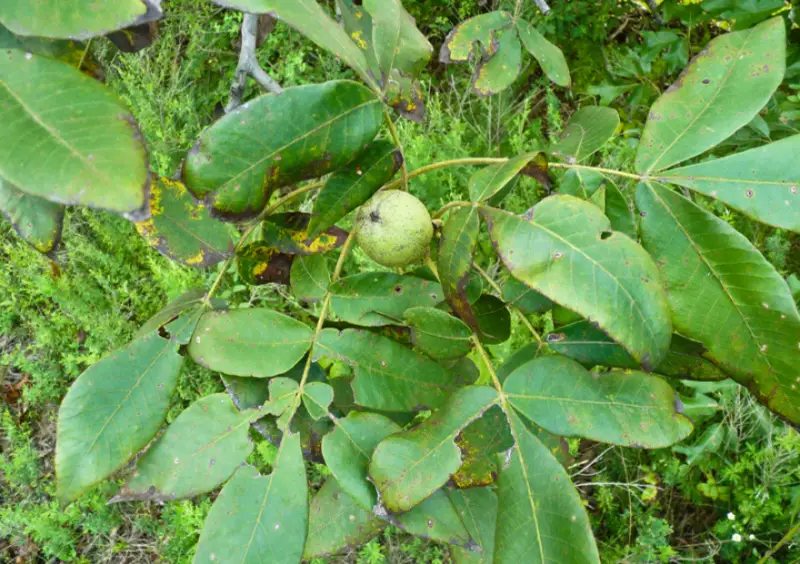
Mockernut Hickory (Carya tomentosa), also known as white hickory or whiteheart hickory, is a medium to large tree, reaching heights of 50 to 100 feet. It features a straight trunk and an oblong crown with spreading branches.
In densely wooded areas, the lower half of the trunk remains branchless, whereas in open spaces, the crown extends lower to the ground. The bark of mature trees is gray to dark gray and relatively coarse, characterized by forking or intertwining ridges that are somewhat irregular. These ridges are separated by furrows that range in color from gray to reddish brown.
The bark on the branches is smoother and gray, while the twigs are stout and vary in color from gray to grayish brown. Young shoots are light green, light brown, or brown and are densely covered in fine hairs, adding to their sturdy appearance.
Bitternut Hickory
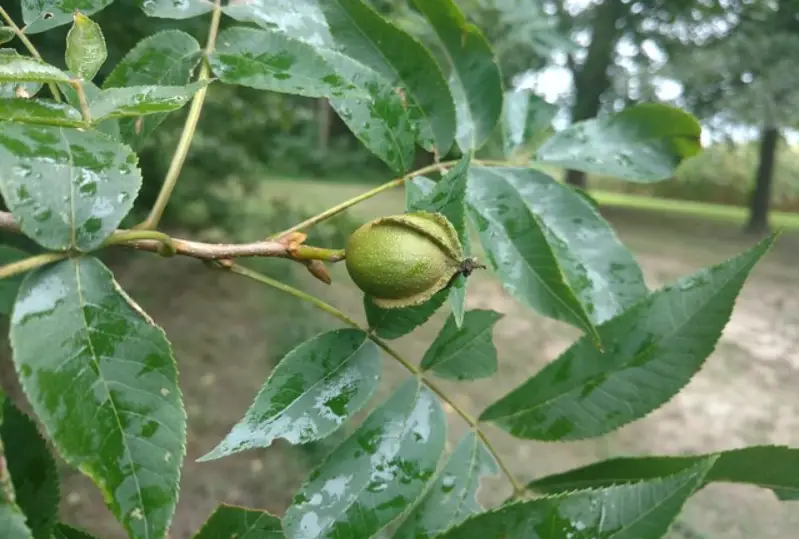
Bitternut Hickory (Carya cordiformis) is a medium-sized tree that becomes more rounded with age. It is easily recognized by its smooth bark and distinctive sulfur-yellow buds. The pinnate leaves typically consist of 5 to 9 bright green leaflets, which turn a striking yellow in the fall.
As its name suggests, Bitternut Hickory produces a bitter-tasting nut. In forested areas, the tree develops a long, straight trunk with a shorter, more compact crown. However, when grown in open areas, the trunk is shorter, and the crown expands into a larger, ovoid shape.
Throughout the year, Bitternut Hickory can be identified by its long, scaly, yellow buds, a feature unique among native trees. On bottomlands, this tree can grow 50 to 70 feet tall or more, with a straight trunk that can reach 1 to 2.5 feet in diameter. Its wood is hard and heavy, making it valuable for furniture, paneling, and tool-making.
Scrub Hickory
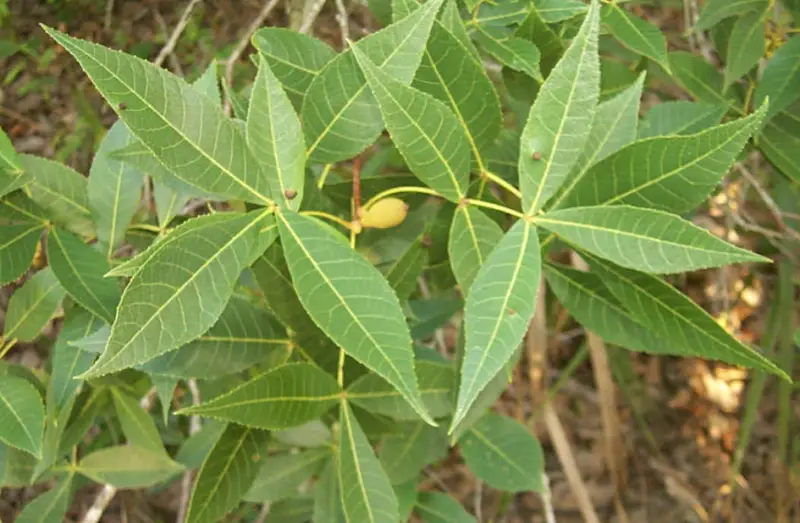
Scrub Hickory (Carya floridana) is a tree-shrub species that typically grows to about 16 feet (5 meters) tall, though some specimens can reach heights of up to 80 feet (25 meters). This small hickory tree features 12-inch (30 cm) leaves composed of seven broad, pointed leaflets.
The Scrub Hickory produces small, edible drupes, adding to its unique appeal. Native to the southeast United States, it is particularly endemic to central Florida, which is reflected in its botanical name, Carya floridana. Despite its relatively small size, Scrub Hickory can still make a notable impact in its natural habitat.
Sand Hickory

Sand Hickory (Carya pallida) is a slow-growing deciduous tree that can reach heights of up to 80 feet (24 meters). Its bark is smooth, featuring shallow furrows arranged in a distinctive network pattern. The tree’s pinnate leaves are shiny and consist of pointed leaflets, which give it an elegant appearance.
In addition to its attractive foliage, Sand Hickory produces small edible drupes, contributing to its ecological value. While it may take time to reach maturity, this hickory tree adds visual appeal to its surroundings with its glossy leaves and distinctive bark texture.
Red Hickory
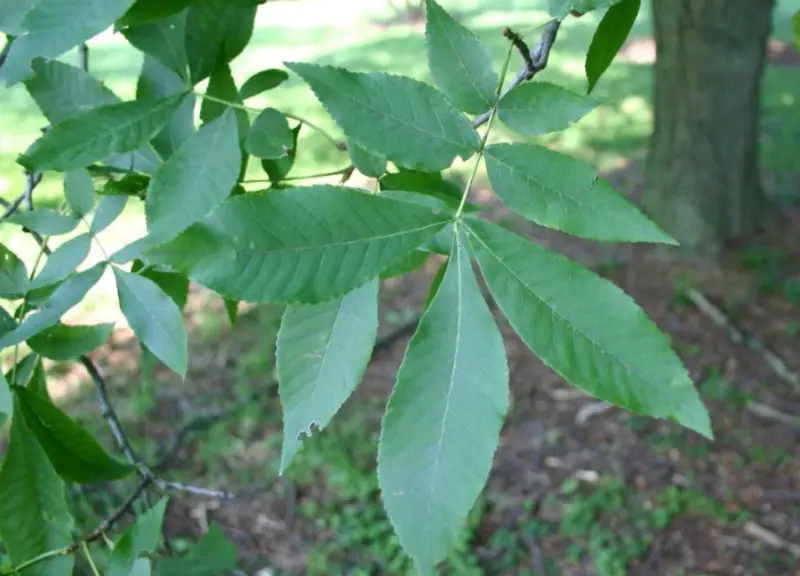
Red Hickory (Carya ovalis) is typically a medium-sized tree, but it has the potential to grow as tall as 30 meters (100 feet). It usually features a straight, single trunk that can extend the entire height of the tree, though sometimes it splits into several large limbs after the canopy is reached.
The branches are robust and long, with the upper branches ascending, the lower ones drooping, and the mid-level branches growing more horizontally. This creates a broad, thick, columnar shape, providing dense shade beneath its canopy.
Red Hickory trees are known for their longevity, with some individuals living between 100 to 250 years. This tree’s strong structure and impressive size make it a notable feature in many landscapes.
Nutmeg Hickory
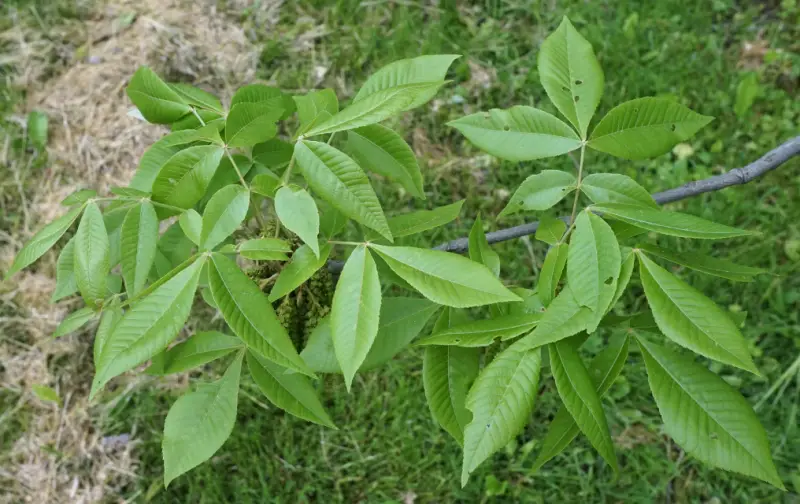
Nutmeg Hickory (Carya myristiciformis) is a small to medium-sized tree characterized by its short, crooked branches and narrow crown. It typically reaches heights of 30 to 60 feet and can form a trunk that measures up to 2 feet in diameter, resulting in a variably shaped crown.
The bark of Nutmeg Hickory is dark gray to black, tight, and non-scaly, featuring irregular blocky ridges and deep furrows that contribute to its rugged appearance. The twigs are slender and often crooked, tapering abruptly to the terminal bud, which is adorned with fuzzy, rusty scales on young twigs and buds.
This hickory species thrives in a range of soils, including loamy, silty, or clayey types that are moist but well or moderately well-drained, enriched with mineral nutrients. Nutmeg Hickory is commonly found in minor stream bottoms, second bottom flats, and on slopes or bluffs adjacent to streams, where it plays a role in the ecosystem.
Water Hickory
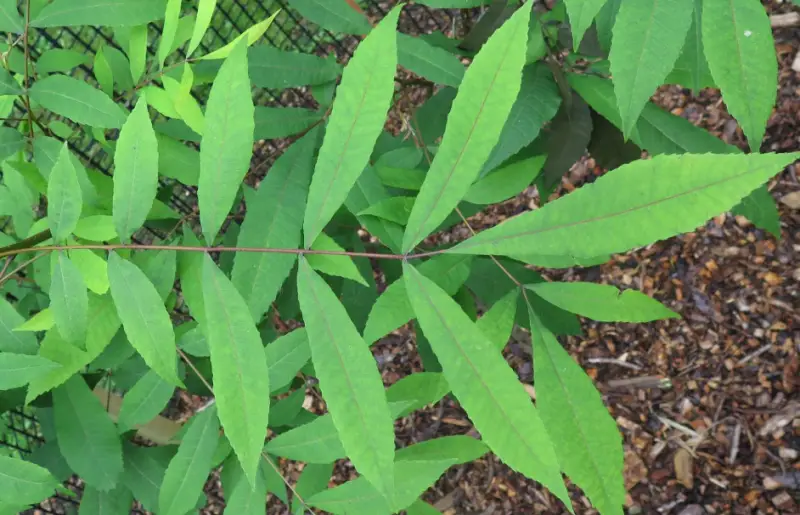
Water Hickory (Carya aquatica) is a prominent species found in clay flats and backwater areas adjacent to streams and rivers in the southern United States. This large tree can reach heights of over 30 meters (98 feet) and is commonly referred to as “bitter pecan” due to the taste of its nuts.
Water Hickory is known for its aggressive reproduction, thriving both from seed and by sprouting new growth from its root system. While it is tolerant of wet soils, this species grows best in well-draining soils located near rivers and other waterways.
The bark of Water Hickory is dark gray to black and has a tight texture that is not scaly. It features irregular blocky ridges and deep furrows that add to its rugged appearance. The twigs are slender and often crooked, tapering abruptly to the terminal bud. Young twigs and terminal buds are covered in fuzzy, rusty scales, further enhancing the tree’s distinctive look.
Vietnamese Hickory
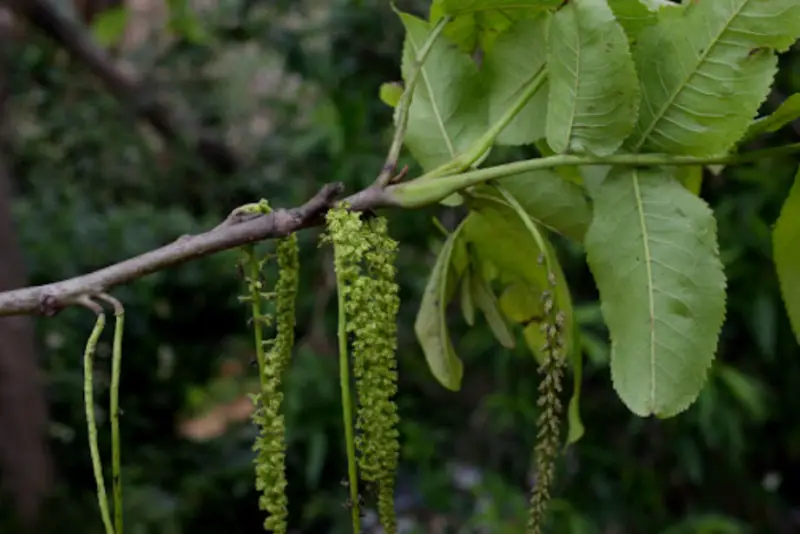
Vietnamese Hickory (Carya tonkinensi) is a deciduous tree characterized by its smooth, tight, grayish bark. The current season’s shoots culminate in clusters of bright orange leaf buds, which derive their vibrant color from an abundance of orange peltate scales, with no bud scales present.
The leaves of Vietnamese Hickory are odd pinnately compound and can grow up to 38 cm long, including the petioles. The petioles themselves are densely hairy, featuring very short hairs. Typically, there are 5 to 7 leaflets per leaf. The lateral leaflets are arranged oppositely and exhibit an ovate-lanceolate to oblanceolate shape, acuminate tips, and bases that can be subrounded to cuneate, with a simple serration along the edges.
Notably, the terminal leaflet and the first pair of lateral leaflets are larger than the more distal leaflets. The leaflets are adorned with reddish-orange peltate scales on their abaxial (underside) surfaces and are puberulous along the midrib, while the adaxial (upper) midrib also exhibits a puberulous texture. This combination of features makes Vietnamese Hickory a distinctive species in its native habitat.
Chinese Hickory
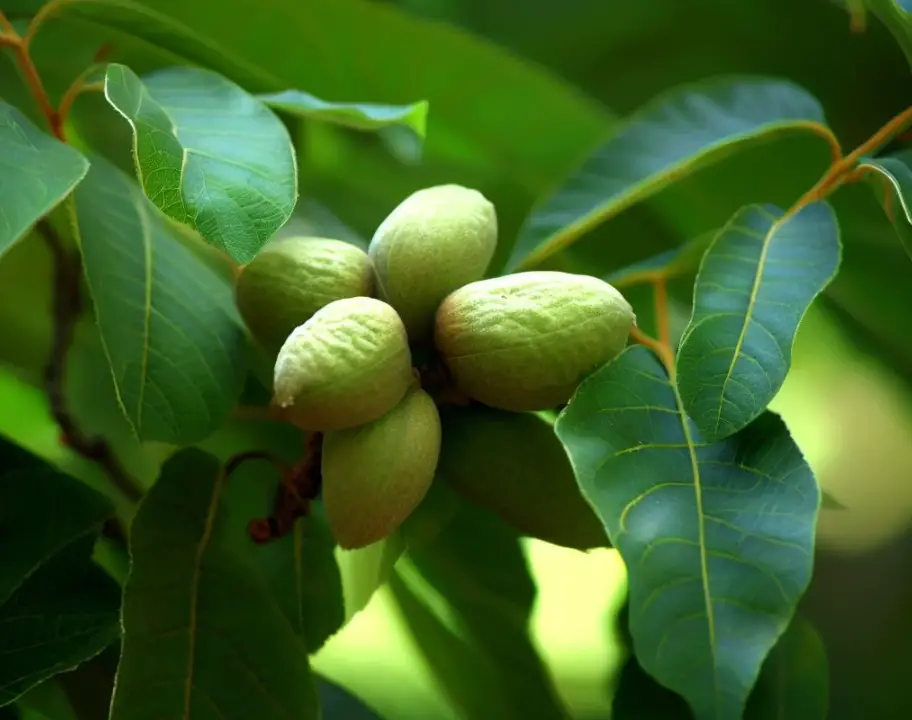
Chinese Hickory (Carya cathayensis) is a deciduous tree native to China, recognized for its robust structure and attractive foliage. This tree typically grows to a height of 15 to 20 meters (approximately 50 to 65 feet) and features a straight trunk that can reach a diameter of up to 60 centimeters (about 24 inches).
The bark of Chinese Hickory is smooth when young, becoming more textured and fissured as it matures, presenting a dark gray to brownish appearance. The leaves are odd pinnate, usually consisting of 5 to 9 leaflets that are glossy green and can grow up to 30 centimeters (about 12 inches) long. Each leaflet has a lanceolate shape, with finely serrated margins and a slightly pointed tip, enhancing the tree’s ornamental appeal.
Chinese Hickory produces small, edible nuts encased in a thin shell, which are highly valued for their flavor and nutritional content. The tree prefers well-draining soils and is often found in mixed forests, where it contributes to the biodiversity of the ecosystem. Its resilience to various environmental conditions makes it a popular choice for both reforestation efforts and landscape planting.






